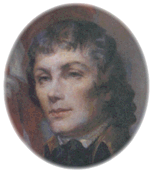


Kosciuszko was on February 4, 1746 in Poland. His family was in the ruling class and he received a good education at a school run by the Church. At 19 he joined the new Royal Military School in Warsaw, Poland. In 1769 at the age of 23 he graduated with honors and was made Captain. He then received a scholarship from King Stanislaw and in August went to Paris to study engineering and artillery.
He returned to Poland in 1774. His country had been at war and lost a lot of territory. Since he didn't have much to do in the military, he decided to join the Colonists cause in the New Americas. He arrived in Philadelphia in August 1776 and was the first person to come from Europe to enlist in the Continental Army.
He was made Colonel of Engineers and assigned to General Horatio Gates whose army was in the north. Many people think that it was Colonel Kosciuszko's strategy that gave the Continentals the victory at Saratoga. The victory at Saratoga convinced European countries to join the Continentals in their war for independence.
General Washington sent Kosciuszko to fortify West Point, which Washington called "the key to America." For almost two and a half years, Colonel Kosciuszko supervised the work to block the Hudson River and keep the British from moving South. West Point today is the home of the U.S. Military Academy and the first monument was built by the cadets in order to Kosciuszko.
After finishing his work at West Point, he was sent to help the Continental Army in the South. He supervised the troops as they crossed rivers and dangerous swamps. He led the Continentals into a victorious seige of Charleston harbor. After the war, Congress made him a Brigadier General.
He returned to Poland in 1784 and in 1789 enlisted in the Polish army. When it became clear that Poland could not win the war, they withdrew. This upset Kosciuszko so he left for Germany, but kept in contact with other Polish citizens who wanted their country back. In 1794 he returned to Poland and led a revolt. Since he learned in the colonies how to organize an untrained army, he was able to win an important battle at Raclawice with 7,000 untrained men. In the end Poland lost the war and Kosciuszko was a prisoner in Moscow. When Czar Paul I took over the throne, he freed Kosciuszko if he promised not to go back to Poland.
After being freed in Moscow, he traveled back to America and settled in Philadelphia. He met almost daily with his friend, Thomas Jefferson. When Kosciuszko left America for the last time, he left Thomas Jefferson in charge of his affairs. Upon his death, Thomas Jefferson was directed to use the money to buy slaves and then to free them.
He left the Americas and settled in Switzerland with some friends, where he died in October of 1817. After Poland was re-established as a nation, his body was returned to Poland and today is in a royal crypt in Cracow's Wawel Cathedral.
Kosciuszko helped to free the colonies from British rule, but could not do the same for his own country. He remains an important symbol to the American Poles.
At his death, Thomas Jefferson is quoted as having said:
| He was a pure a son of Liberty as I have ever known, and of that liberty which is to go to all, not to the few and rich alone. |



